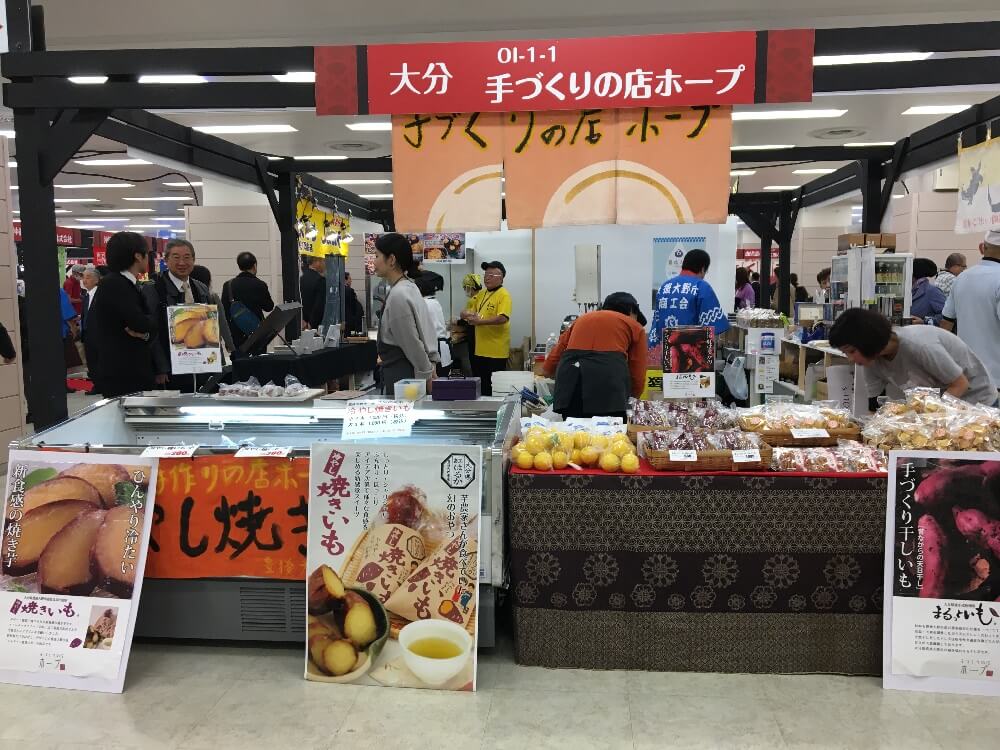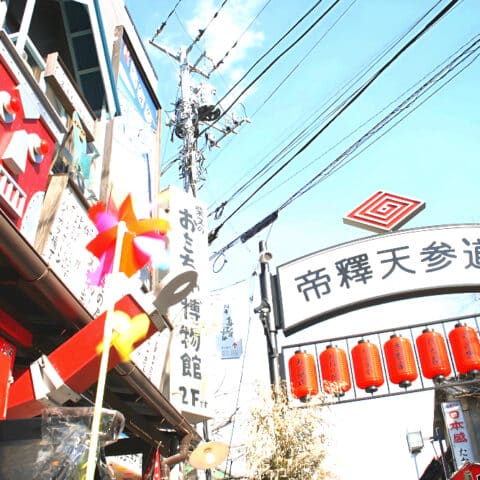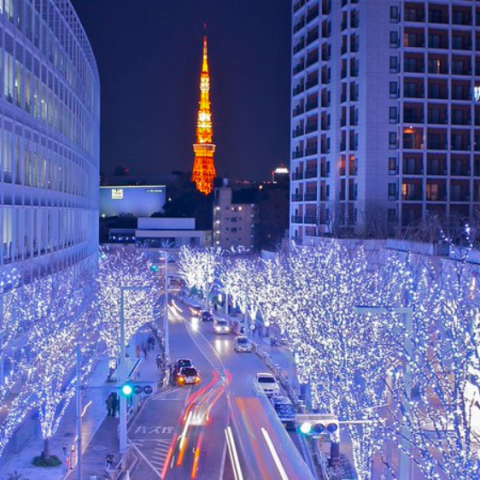
That sounds like a simple question with a simple answer, right? Well, for anyone who has lived in Japan for any length of time, that question is far from simple. Each of the 47 prefectures of Japan has its own local specialty food and desserts.
To describe any one of the prefectural palates as representative of ‘Japanese food’ as a whole is a gross generalization of what makes each location unique, implying that one prefecture’s tastes applies to the entirety of Japanese cuisine.
This will become immediately apparent to anyone who attends the Japan Foods and Products Fair held each year at Ikebukuro’s Sunshine City Mall. We at Arigato Japan Food Tours had the pleasure of being present at the 2019 event and can tell you that it is a must-attend experience for any foodie traveling in Japan. In just one stop, you get to sample bite-sized portions of food from places all over Japan where you would otherwise have to travel to in order to taste!
Here is what visitors to future Japan Foods and Products Fair events can expect from the experience!

The Sights, Scents, and Tastes
As you approach the event site, if the crowds of hungry people don’t signify that you’ve found the right place, then the smell of freshly cooked or baked food certainly will! Your nose will first be greeted by a mixture of scents like sweet potatoes, cooked and raw seafood, hot red bean paste, fried meat, fish broths, fresh pastries and so much more.
In Sunshine City’s Exhibition Hall A, we found dozens of booths with the names of the prefectures and cities that they represent. Products on offer at each booth include specialty food products, teas, wines, sweets, textiles, crafts, and clothing, all of which can be purchased and taken home. Many of the food and drink booths will even have free samples for you to taste! In the span of just 30 minutes in this one hall, we got to taste:
–Mochi rice cakes made in the villages of Yamaguchi
-Pickled daikon radishes from Fukui
-Fried ikaten squid cakes from Shizuoka
–Takanazuke mustard leaves from Nagasaki
–Senbei rice crackers bearing the image of a mascot character from Toyama
-Kobe-style gyoza and shumai dumplings from Hyogo
–Mentai Pollack roe from Aichi
-Dried kuro ninniku garlic from Osaka
And that’s just the tip of the iceberg of what else you can taste at the Japan Foods and Products Fair!

Food Court
Don’t fill up on free samples though, or else you’ll miss out on the food offered at the fair’s highly diverse food court! Located right across from Exhibition Hall A, it’s where you’ll find food stalls cooking up all sorts of local delicacies from the prefectures and cities that they represent! Here are the specific dishes that we got to enjoy on the day that we visited:

Goto Udon
The Goto Isles are the westernmost islands of Japan. Separated from the mainland, their food is not often eaten by the majority of Japanese people, let alone foreigners. It was for this reason that I was attracted to the Nagasaki stall for a bowl of fresh Goto-style udon noodles.
The noodles were served with kombu seaweed, sprinkles of tenkasu crisps, chopped negi green onions, and slices of kamaboko fish cake. But the udon noodles were definitely the star of the dish, super soft, delicate, and going down easy, especially with the complimentary tea that they served. Being able to sample such a heavenly bowl of udon made fresh in Tokyo will be a dream come true for any fan of Japanese noodles.

Saga Bacon Steak
“What’s so special about bacon?” you may be wondering. Well, if it’s a Saga-style bacon steak, then the answer is everything. Rather than the thin and dry, crispy variety, the slices of this bacon steak were thick-cut, super juicy, and their texture so soft that it melts in your mouth like high-quality pork belly. Lightly peppered and served with asazuke sauerkraut, it was easily the best bacon I’ve ever eaten. The only regret that I have about tasting it is that I will now never be able to enjoy the more common, greasy pan-fried bacon again!

Oita Atsumeshi Donburi
I next headed to the Oita stall where they were serving a specialty donburi rice bowl called atsumeshi. In it, the rice is topped with thin slices of soy sauce-marinated fish, cuts of dried seaweed, green onions, and sesame seeds. Wasabi could also be added as an option, and the sashimi-lover in me couldn’t resist the offer.
After mixing all the ingredients in the bowl – including the wasabi – and taking a big bite, I was felt like I was in nirvana with the taste of my favorite sashimi mixed with quality rice that you would expect from a donburi bowl. Combined with the wasabi, it wouldn’t be inaccurate to liken it to eating a piece of sushi large enough to fill your whole mouth!
I didn’t even have to wait for the hot rice to cool because the fish was served cold just like any sashimi and helped balance out the heat from the rice when taking a bite. Any lover of sashimi and/or donburi will fall head over heels in love with this dish, perhaps even enough to consider a trip to Oita!

Oyatsu Hall
What better way to end a meal than with dessert? From the food court, go up one flight of stairs to reach Exhibition Hall B of Sunshine City where the showcase even more booths. The stars of this hall are the special oyatsu snack booths lining the walls of the room!
Anyone who has seen or tried Japanese snacks will know how pretty-looking and ‘Instagram-able’ they are, not to mention delectable, and there will be no shortage of region-specific oyatsu to sample during the Japan Foods and Products Fair! Here’s what we were fortunate enough to stumble upon and try:
 5-Variety Aichi Dango
5-Variety Aichi Dango
Dango are tiny dumplings made from sweet mochiko rice flour that can be served with a vast variety of toppings. And at the Aichi booth, they offered no less than five different varieties of dango in one convenient package!
The first stick I tried was the one most familiar to me: the azuki red bean dango. Azuki is a staple ingredient in many Japanese treats, and for good reason. It’s sweet stuff and goes wonderfully with just about anything, including dango!
Next was the roasted kinako soy flour dango. This type is more nutty flavored and less sweet, making it a nice choice for those who can’t handle extremely sweet desserts.

Going back to the sweet variety was the mitarashi dango. Covered in syrupy soy sauce glaze, taking a bite of this dango made my sweet tooth happy again!
After that was the sakura cherry blossom dango. This was the prettiest dango of them all and I almost felt bad about eating it… “almost” being the key word, because all my guilt about consuming something so beautiful went away once that creamy sweet sensation hit my tongue!
But I saved the very best for last: the murasaki imo sweet potato dango. Potato may not seem like a very dessert-like ingredient to Westerners, but the Japanese people know how to use sweet potato masterfully in treats and desserts, especially the purple murasaki imo variety. This sweet vegetable spread on the dango not only tasted the best to me, but it was also probably the healthiest variety given the nutritional value of sweet potato.
 Akita Namahage Crackers
Akita Namahage Crackers
One booth that caught my eye while I was wandering around was the Akita booth where they were selling namahage crackers. Namahage are demons in Akita folklore who wear oni ogre masks and scare naughty children into behaving better. Knowing that this was a rare opportunity to taste something specific to Akita, I bought one of the crackers to try out.
The front side of the cracker is indeed a thin wafer shaped like a namahage face covering its soft cookie-like interior. Whether eating one makes Akita kids more or less afraid of namahage, I don’t know, but they make a very satisfying snack either way!
 Aomori Squid Monaka
Aomori Squid Monaka
Much like the namahage-shaped crackers, the monaka sweets at the Aomori booth also caught my eye for being squid-shaped. I learned that it’s because Aomori is known to be a prime area for squid fishing, so its own local take on a classic treat like monaka would be shaped like a squid. Even the words tairyou (大漁), meaning “big catch,” are written on the back of them.
As I bought and bit into one, my tastes buds were once again greeted by that the thick, rich flavor of azuki red bean which I never grow tired of and always enjoy. But as I took more bites, I made another sweet discovery: in the very middle was a kuri chestnut! Kuri is another staple ingredient in Japanese sweets, and the fact that this monaka contained both of them made it extra satisfying!

If reading this has got you interested in attending the next Japan Foods and Products Fair, be sure to visit the event’s website and Facebook page to find more media and information about it!
Japan Foods and Products Fair
Website: https://www.all-nippon.jp
Facebook page: https://www.facebook.com/allone.nippon



